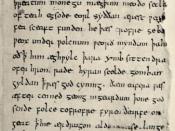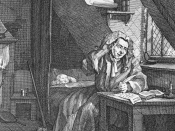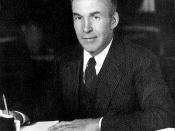The way one analyzes any aspect of life depends a great deal on the way one grew up or what was learned throughout the course of life. Such is also true with literature. Initially in Janet Burroway's poem, "The Scientist," the two characters appear to fit the stereotypical roles of their professions. The uncertainty this causes throughout the poem allows the reader to apply a universal theme to life. It is through Burroway's language, imagery, and irony that she creates an unlikely-shared awareness between the poet and scientist.
The structure of this nine-stanza poem makes it easy for the reader to relate tones associated with select stanzas. The poem opens with the male scientist explaining how "There is nothing mysterious about the skull" (ln 1), and the female poet having made an inquiry about the skull. With what would traditionally be great discrepancies in lifestyles, these characters are able to find similar beliefs.
As a female of an artistic, figurative, background, the poet focuses on wonder and amazement from the skull. Whereas, the male with conventional and literal boundaries, appears to be held back by his education and experience with the skull, saying it is "dull."
In the third, fourth and fifth stanza the scientist explains features of the skull. The scientist has medical terminology when responding about the skull. "Cranium, formed of the commonest elements; / Weighing nine ounces, worth about fourteen cents" (ln 18-19). From this view the scientist looks at this structure with a trained eye, thus within boundaries and based on facts. This is why he uses his very direct, figurative language.
On the other hand, the poet has an almost ornate diction when she describes the observations from the skull and the scientists' interaction with it which is described various points throughout the...


